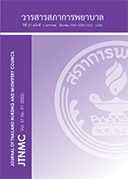Range of Joint Motion in Patients with Extremity Injuries: Assessment and Nursing Practice
Keywords:
range of motion, extremity injury, assessment, factors, nursing practiceAbstract
The range of joint motion is a movement dependent upon well-coordinated activities of the joints, muscles, tendons, and nerves, and central to performance of daily routines, such as sitting, standing, walking, and doing physical exercise. A physical injury can decrease both the perception of joint motion and the angles of joint bending and stretching, resulting in defciency or limitation of joint and other bodily functions, especially in patients with short-term extremity injuries. Such defcient joint motion may also affect extremity injury patients’ long-term, comprehensive restoration of joint and other bodily functions.
This academic article serves two major purposes. First, it explains a method of assessing the range of joint motion by measuring factors that could affect the range of joint motion. Second, it proposes an exercise-integrated nursing-care method that engages extremity injury patients in various forms of physical exercise, namely, passive exercise, active exercise, isometric exercise, and isotonic exercise.
Based on the study, it is recommended that nurses improve the range of joint motion immediately when the patients start receiving treatment. Great care must be taken to monitor the patients’ joint movement and to prevent complications during the period of joint function rehabilitation. Nurses are also advised to regularly assess the range of joint motion and the progress of joint function rehabilitation, in order to ensure that the extremity injury patients perform joint movements continually, appropriately, and effectively, thereby maintaining their muscular strength. An equally important factor contributing to the patients’ rehabilitation is prevention of subsequent defciency of range of joint motion. Such preventive process could restore the patients’ ability to perform daily routines after being discharged.
Downloads
References
Jung H, Yamasaki M. Association of lower extremity range of motion and muscle strength with physical performance of community dwelling older women. J Physiol Anthropol. 2016;35(30):1-9.
PundeeJ,ChayaputP,ChanruangvanichW,Wannatoop T. Predictors of functional restoration in extremity injury patients. Journal of Thailand and Midwifery Council. 2019;34(4):48-63. (in Thai)
Farhan H, Moreno-Duarte I, Latronico N, Zafonte R, Eikermann M. Acquired muscle weakness in the surgical intensive care unit. Anesthesiology. 2016;124(1): 207-34.
Fairhurst P, Wyss T, Weiss S, Becker D, Schmidli J, Makaloski V. Popliteal vessel trauma: surgical approaches and the vessel-frst strategy. Knee. 2018;25(1): 849–55.
Oliveira M, Macedo O, Silva L, Oliveira T, Bottaro M, Martins W. Structural and physical functional defcits in lower limbs with fractures and treated surgically. Fisioterapia em Movimento. 2018;31(1): 1-12.
Mahdian M, Fazel R, Sehat M, Khosravi G, Mohammadzadeh M. Epidemiological profile of extremity fractures and dislocations in road traffic accidents in Kashan, Iran: a glance at the related disabilities. ArchBonejtSurg.2017;5(3):186-92.
MukpradabS,SongwathanaP,Sea-siaW.An outcome oriented movement supporting programme and its musculoskeletal outcomes as observed in trauma patients suffering from immobilisation: a pilot study. Thai Journal of Nursing Council. 2014;29(2): 49-60. (in Thai)
Baczkowicz D, Skiba G, Falkowski K, Domaszewski P, SelkowN.Effectsofimmobilizationandre-mobilization on knee joint arthrokinematic motion quality. J Clin Med. 2020;451(9):1-11.
CarpenitoL.Handbook ofnursing diagnosis. 15thed. Philadelphia: Lippincot Williams & Wilkins, 2016.
Herdman H, Kamitsuru S. Nursing diagnoses: defnitions and classifcation. 11thed.Wiley Blackwell, 2020.
VinsonR,KannS,GaonaD,PanacekA.Performance of the 4-way range of motion test for radiographic injuries after blunt elbow trauma. Am J Emerg Med. 2016;24:235-9.
Kasem A, Aly S, Kamel E, Hussein H. Normal active range of motion of lower extremity joints of the healthy young adults in Cairo, Egypt. Bull Fac Phys Ther. 2020;25(2):1-7.
KnightJ, Nigam Y. Effects of bed rest 5: the muscles, joints and mobility. Nurs Times.2019;115(4):54-7.
Chang L, Jung H, Kwak H, Kim K, Lee H, Jung Y, et al. Quality improvement activity for improving pain management in acute extremity injuries in the emergency department.ClinExpEmergMed.2018;5(1):51-9.
DavisM,GriffnS,ChuG,WenkeC,CoronaT,McKinley O,etal.Muscle bone interactions during fracture healing. J Musculoskelet Neuronal Interact.2015;15(1):1-9.
CronenwettJ, JohnstonW.Acute is chemia: evaluation and decision making, in Rutherford’svascular surgery. 7th ed. Philadelphia: Saunders Elsevier. 2014.
Lee HJ, Cho Y, Joo H, Jeon JY, Jang YE, Kim JT. Comparative study of verbal rating scale and numerical rating scale to assess postoperative pain intensity in the post anesthesia care unit A prospective observational cohort study. Medicine. 2021;100(6):1-6.
Weigel K, Nickel C, Malinovska A, Bingisser R. Symptoms at presentation to the emergency department: predicting outcomes and changing clinical practice. Int J Clin Pract. 2018;72(1):1-10.
Trairatnopas V, Morsup T. The roles of nurses on complication prevention in patients having traction for treatment of fracture. Srinagarind Medical Journal. 2020;26(3):110-21. (in Thai)
Doiron K, Hoffmann T, Beller E. Early intervention mobilization or active exercise for critically ill adults in the intensive care unit. Cochrane Database Syst Rev. 2018;3(3):1-20.
Nitkiewicz S, Smieja M, Gogolewski T, Majchrowski A, Grabarczyk L, Maksymowicz W. Objectifcation of diagnostic symptoms in examination of nervous system damage by static interactions and kinematic parameters of ankle joint. Acta Phys Pol A. 2014; 125(4):27-30.
Downloads
Published
How to Cite
Issue
Section
License
Copyright (c) 2022 Thai Journal of Nursing Council

This work is licensed under a Creative Commons Attribution-NonCommercial-NoDerivatives 4.0 International License.








